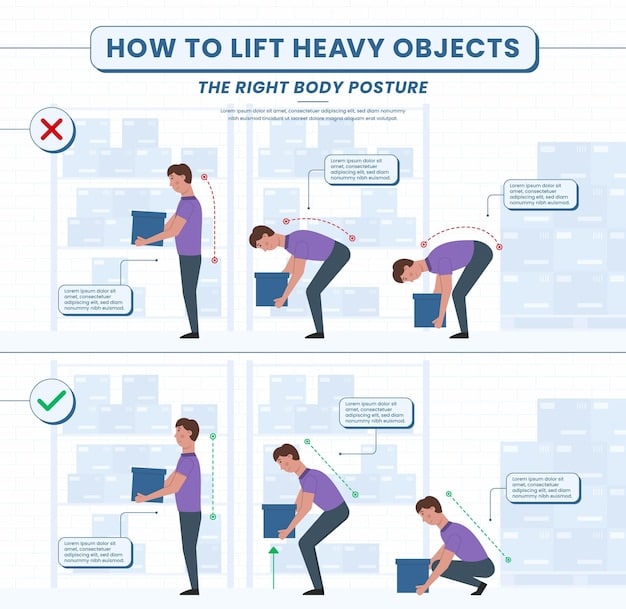Prevent Back Pain: Simple Posture Adjustments You Can Make Today

Prevent back pain by making simple posture adjustments today, including sitting with lumbar support, standing tall with shoulders back, and correctly lifting heavy objects, promoting long-term spinal health.
Do you know that prevent back pain: simple posture adjustments you can make today? Back pain is a common problem, but thankfully, simple posture adjustments can make a big difference.
Understand the Root Causes of Back Pain
Back pain can stem from a variety of issues, often exacerbated by poor posture and everyday habits. Understanding these root causes is the first step toward effective prevention.
Identifying the underlying factors contributing to your discomfort can help you make targeted adjustments to reduce strain and pain. Let’s delve into some common causes.
Poor Posture
One of the most prevalent causes of back pain is poor posture. Whether you’re sitting, standing, or even sleeping, your body position can significantly impact your spine.
Slouching or hunching forward can place excessive strain on your back muscles and ligaments, leading to discomfort and pain.
Sedentary Lifestyle
A sedentary lifestyle, characterized by prolonged periods of sitting, can also contribute to back pain. Lack of physical activity weakens core muscles, which are essential for supporting the spine.
Additionally, sitting for extended periods can compress spinal discs and decrease circulation, further aggravating back pain.
Improper Lifting Techniques
Lifting heavy objects incorrectly is a common culprit of back injuries and pain. Bending at the waist instead of lifting with your legs can place tremendous stress on your lower back.
Over time, this can lead to strains, sprains, and even more serious conditions like herniated discs.
Other potential causes include:
- Obesity: Excess weight puts additional strain on the spine and supporting muscles.
- Stress: Tension can cause muscles to tighten, leading to back pain.
- Age: As we age, spinal discs can degenerate, increasing the risk of pain.
By recognizing these root causes, you can start making informed changes to your lifestyle and posture to prevent and alleviate back pain.
Understanding these factors is essential for taking proactive steps to safeguard your spinal health and enhance your overall well-being.

Evaluate Your Everyday Posture
Evaluating your everyday posture is essential to identify areas where you can improve and prevent back pain. Being mindful of how you sit, stand, and move can significantly impact your spinal health.
Assessing your posture throughout the day can help you pinpoint habits that contribute to discomfort and make necessary adjustments.
Sitting Posture
When sitting, ensure that your lower back is supported. Use a chair with good lumbar support or add a cushion to maintain the natural curve of your spine.
Keep your feet flat on the floor or use a footrest. Avoid crossing your legs, as this can disrupt circulation and cause uneven pressure on your hips and back.
Standing Posture
When standing, keep your shoulders back and down, and your head level. Distribute your weight evenly on both feet.
Engage your core muscles to help support your spine. Avoid locking your knees, as this can cause strain on your back.
Sleeping Posture
Your sleeping posture can also influence back pain. Sleep on your side with a pillow between your knees to keep your spine aligned.
If you prefer to sleep on your back, place a pillow under your knees to reduce strain on your lower back. Avoid sleeping on your stomach, as it can arch your back and cause discomfort.
Practical Tips for Posture Evaluation:
- Use a Mirror: Periodically check your posture in a mirror to identify areas for improvement.
- Set Reminders: Use alarms or reminders to check your posture throughout the day.
- Ask for Feedback: Have someone take a photo of you while sitting or standing to assess your posture.
By regularly evaluating your posture and making conscious adjustments, you can create healthier habits that support your spine and prevent back pain.
This proactive approach not only alleviates discomfort but also enhances your overall posture and well-being, promoting a healthier and more aligned body.
Optimize Your Workspace Ergonomics
Optimizing your workspace ergonomics is vital for preventing back pain, especially if you spend long hours at a desk. A well-designed workspace promotes good posture and reduces strain on your spine.
Creating an ergonomic environment tailored to your needs can significantly improve your comfort and long-term spinal health.
Adjust Your Chair
Start by adjusting your chair to the correct height. Your feet should be flat on the floor, and your knees should be at a 90-degree angle.
Ensure your chair has good lumbar support or use a cushion to maintain the natural curve of your spine. Adjust the armrests so that your shoulders are relaxed.
Position Your Monitor
Position your monitor at arm’s length and at eye level. This prevents you from straining your neck and upper back.
If you use multiple monitors, arrange them so you can view them without excessive twisting or turning.
Use a Standing Desk
Consider using a standing desk to alternate between sitting and standing throughout the day. Standing desks can help reduce sedentary behavior and improve posture.
If you’re new to standing desks, start with short periods and gradually increase the time as you become more comfortable.
Essential Ergonomic Accessories:
- Keyboard and Mouse: Use an ergonomic keyboard and mouse to reduce strain on your wrists and hands.
- Footrest: A footrest can help maintain proper posture and reduce pressure on your lower back.
- Document Holder: Place documents at eye level to avoid straining your neck.
By optimizing your workspace ergonomics, you can prevent back pain and improve your overall comfort and productivity. Small changes can make a big difference in your spinal health.
Investing in an ergonomically sound workspace ensures that you maintain good posture, reduce strain, and support long-term well-being while working.

Incorporate Simple Stretches and Exercises
Incorporating simple stretches and exercises into your daily routine is a proactive way to prevent back pain. Regular movement helps improve flexibility, strengthen core muscles, and support spinal health.
These activities can be easily integrated into your workday or home life, providing significant benefits for your back.
Desk Stretches
Take short breaks throughout the day to perform simple stretches at your desk. Neck rotations, shoulder blade squeezes, and wrist extensions can help relieve tension.
Hold each stretch for 15-30 seconds and repeat several times.
Core Strengthening Exercises
Strong core muscles provide essential support for your spine. Planks, bridges, and abdominal crunches are effective exercises for strengthening your core.
Aim to perform these exercises 2-3 times per week, gradually increasing the intensity as you get stronger.
Yoga and Pilates
Yoga and Pilates are excellent for improving flexibility, balance, and core strength. These practices can help alleviate back pain and prevent future issues.
Consider joining a class or following an online tutorial to learn the correct techniques.
Recommended Stretches and Exercises:
- Cat-Cow Stretch: Improves spinal mobility and reduces stiffness.
- Pelvic Tilts: Strengthens core muscles and promotes spinal alignment.
- Hamstring Stretches: Relieves tension in the lower back and hamstrings.
By incorporating these simple stretches and exercises into your routine, you can prevent back pain and improve your overall physical well-being. Regular movement is key to maintaining a healthy spine.
These exercises not only combat pain but also enhance flexibility and strength, fostering a more resilient and pain-free back.
Learn Proper Lifting Techniques
Learning proper lifting techniques is essential for preventing back pain and injuries, especially when handling heavy objects. Using the correct methods minimizes strain on your spine and reduces the risk of strains and sprains.
Mastering these techniques can protect your back, whether you’re at home, work, or engaging in any physical activity.
Bend Your Knees
When lifting, always bend at your knees and keep your back straight. Avoid bending at the waist, as this places excessive stress on your lower back.
Keep your feet shoulder-width apart for a stable base of support.
Keep the Load Close
Hold the object as close to your body as possible. This reduces the amount of strain on your back muscles.
Use both hands to distribute the weight evenly.
Engage Your Core
Engage your core muscles to provide additional support for your spine. Tighten your abdominal muscles as you lift.
Avoid twisting your body while lifting. Instead, turn your feet in the direction you want to go.
Essential Tips for Safe Lifting:
- Assess the Load: Before lifting, determine if the object is too heavy or awkward to handle alone.
- Get Help: Ask for assistance if needed. Team lifting can distribute the weight and reduce individual strain.
- Use Equipment: Utilize tools such as dollies or hand trucks for moving heavy items.
By learning and practicing proper lifting techniques, you can prevent back pain and protect yourself from injuries. Safe lifting is a crucial component of maintaining a healthy back.
These methods ensure that you distribute weight correctly, minimize strain, and promote long-term spinal health, keeping your back strong and pain-free.
Maintain a Healthy Weight
Maintaining a healthy weight is crucial for preventing back pain and supporting overall spinal health. Excess weight places additional strain on your spine, increasing the risk of back pain and related issues.
Adopting a balanced diet and regular exercise routine can help you achieve and maintain a healthy weight, benefiting your back and overall well-being.
Balanced Diet
Focus on a diet rich in fruits, vegetables, lean proteins, and whole grains. These foods provide essential nutrients that support bone and muscle health.
Limit processed foods, sugary drinks, and excessive amounts of saturated and unhealthy fats.
Regular Exercise
Incorporate both cardiovascular and strength training exercises into your routine. Cardio activities like walking, swimming, and cycling help burn calories and improve cardiovascular health.
Strength training strengthens core muscles, providing support for your spine.
Hydration
Stay properly hydrated by drinking plenty of water. Hydration is essential for maintaining the elasticity of spinal discs and preventing back pain.
Aim to drink at least 8 glasses of water per day.
Lifestyle Tips for Weight Management:
- Portion Control: Be mindful of portion sizes to avoid overeating.
- Meal Planning: Plan your meals in advance to ensure you’re eating nutritious foods.
- Limit Alcohol: Excessive alcohol consumption can contribute to weight gain.
By maintaining a healthy weight through proper diet and exercise, you can significantly reduce your risk of back pain and improve your overall health. A healthy weight supports a healthy spine.
This proactive approach not only lessens strain on your back but also enhances your energy levels and quality of life, promoting a healthier and more active lifestyle.
| Key Point | Brief Description |
|---|---|
| 🧍Adjust Posture | Sit straight, stand tall, and align spine. |
| 🏋️♀️Proper Lifting | Bend knees, keep back straight, hold close. |
| 💪Core Exercises | Strengthen core, improve spine support. |
| ⚖️Maintain Weight | Balanced diet, regular exercise for less strain. |
Frequently Asked Questions
▼
Common causes include poor posture, sedentary lifestyles, improper lifting techniques, obesity, stress, and age-related spinal disc degeneration. Identifying these factors can help in preventing back pain.
▼
Use a chair with good lumbar support, keep your feet flat on the floor, and avoid crossing your legs. Position your monitor at eye level to prevent neck strain.
▼
Neck rotations, shoulder blade squeezes, and wrist extensions are effective desk stretches. Hold each stretch for 15-30 seconds and repeat several times throughout the day to relieve tension.
▼
Bend your knees and keep your back straight. Hold the object close to your body and engage your core muscles. Avoid twisting your body while lifting and always assess the load before lifting.
▼
Excess weight places additional strain on your spine, increasing the risk of back pain. A balanced diet and regular exercise can help you maintain a healthy weight and support overall spinal health.
Conclusion
By implementing these simple posture adjustments and lifestyle changes, you can prevent back pain. Small changes can lead to significant improvements in your spinal health, allowing you to enjoy a more active and pain-free life.





